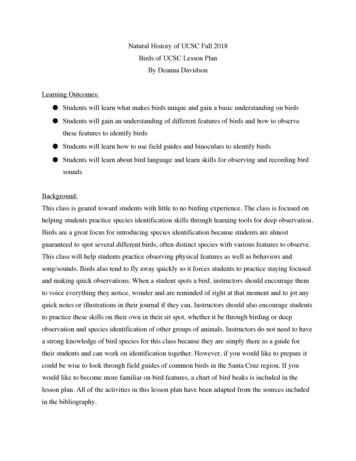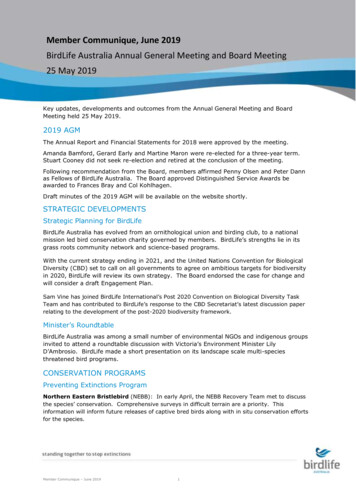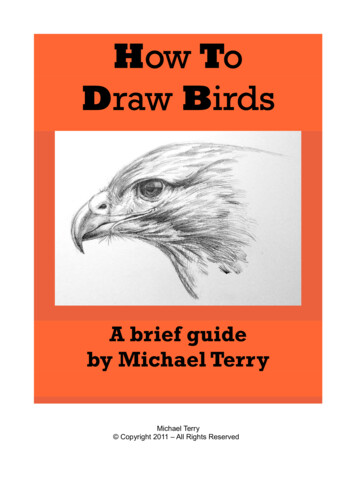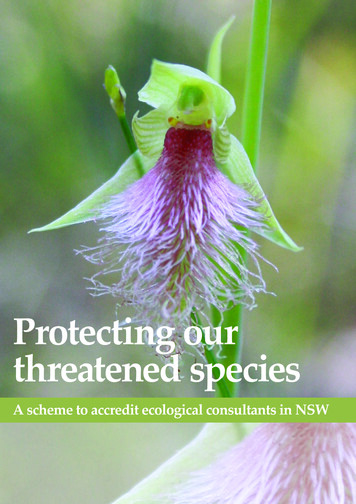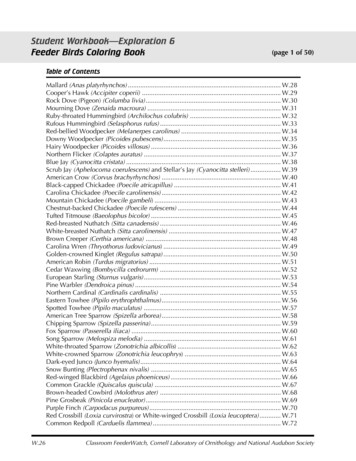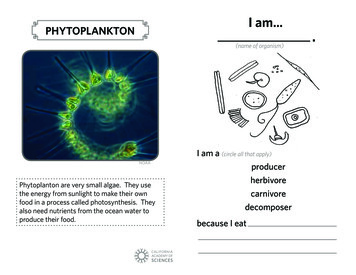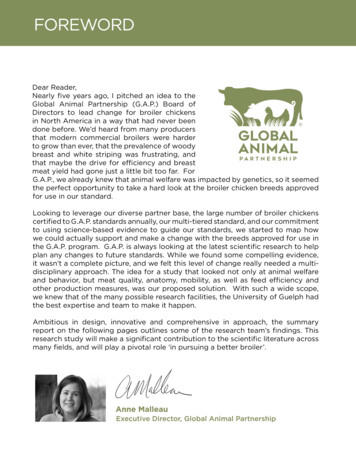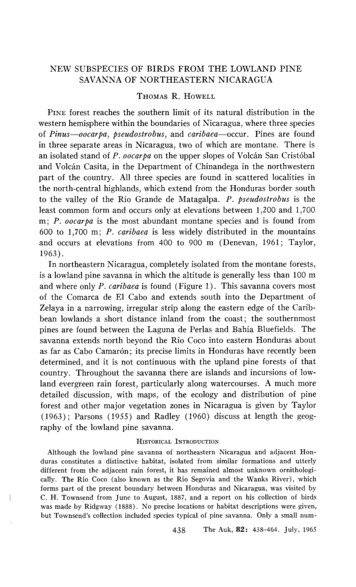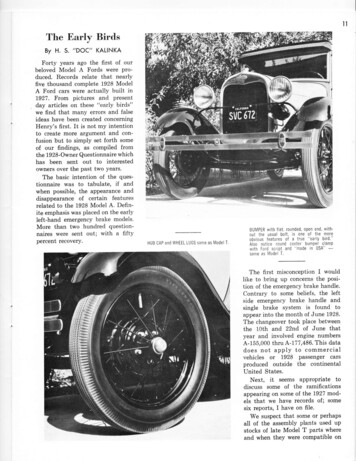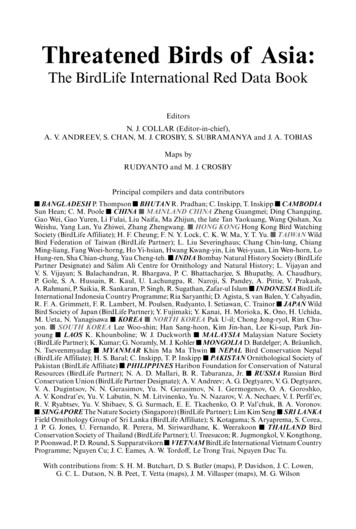
Transcription
Threatened Birds of Asia:The BirdLife International Red Data BookEditorsN. J. COLLAR (Editor-in-chief),A. V. ANDREEV, S. CHAN, M. J. CROSBY, S. SUBRAMANYA and J. A. TOBIASMaps byRUDYANTO and M. J. CROSBYPrincipal compilers and data contributors BANGLADESH P. Thompson BHUTAN R. Pradhan; C. Inskipp, T. Inskipp CAMBODIASun Hean; C. M. Poole CHINA MAINLAND CHINA Zheng Guangmei; Ding Changqing,Gao Wei, Gao Yuren, Li Fulai, Liu Naifa, Ma Zhijun, the late Tan Yaokuang, Wang Qishan, XuWeishu, Yang Lan, Yu Zhiwei, Zhang Zhengwang. HONG KONG Hong Kong Bird WatchingSociety (BirdLife Affiliate); H. F. Cheung; F. N. Y. Lock, C. K. W. Ma, Y. T. Yu. TAIWAN WildBird Federation of Taiwan (BirdLife Partner); L. Liu Severinghaus; Chang Chin-lung, ChiangMing-liang, Fang Woei-horng, Ho Yi-hsian, Hwang Kwang-yin, Lin Wei-yuan, Lin Wen-horn, LoHung-ren, Sha Chian-chung, Yau Cheng-teh. INDIA Bombay Natural History Society (BirdLifePartner Designate) and Sálim Ali Centre for Ornithology and Natural History; L. Vijayan andV. S. Vijayan; S. Balachandran, R. Bhargava, P. C. Bhattacharjee, S. Bhupathy, A. Chaudhury,P. Gole, S. A. Hussain, R. Kaul, U. Lachungpa, R. Naroji, S. Pandey, A. Pittie, V. Prakash,A. Rahmani, P. Saikia, R. Sankaran, P. Singh, R. Sugathan, Zafar-ul Islam INDONESIA BirdLifeInternational Indonesia Country Programme; Ria Saryanthi; D. Agista, S. van Balen, Y. Cahyadin,R. F. A. Grimmett, F. R. Lambert, M. Poulsen, Rudyanto, I. Setiawan, C. Trainor JAPAN WildBird Society of Japan (BirdLife Partner); Y. Fujimaki; Y. Kanai, H. Morioka, K. Ono, H. Uchida,M. Ueta, N. Yanagisawa KOREA NORTH KOREA Pak U-il; Chong Jong-ryol, Rim Chuyon. SOUTH KOREA Lee Woo-shin; Han Sang-hoon, Kim Jin-han, Lee Ki-sup, Park Jinyoung LAOS K. Khounboline; W. J. Duckworth MALAYSIA Malaysian Nature Society(BirdLife Partner); K. Kumar; G. Noramly, M. J. Kohler MONGOLIA D. Batdelger; A. Bräunlich,N. Tseveenmyadag MYANMAR Khin Ma Ma Thwin NEPAL Bird Conservation Nepal(BirdLife Affiliate); H. S. Baral; C. Inskipp, T. P. Inskipp PAKISTAN Ornithological Society ofPakistan (BirdLife Affiliate) PHILIPPINES Haribon Foundation for Conservation of NaturalResources (BirdLife Partner); N. A. D. Mallari, B. R. Tabaranza, Jr. RUSSIA Russian BirdConservation Union (BirdLife Partner Designate); A. V. Andreev; A. G. Degtyarev, V. G. Degtyarev,V. A. Dugintsov, N. N. Gerasimov, Yu. N. Gerasimov, N. I. Germogenov, O. A. Goroshko,A. V. Kondrat’ev, Yu. V. Labutin, N. M. Litvinenko, Yu. N. Nazarov, V. A. Nechaev, V. I. Perfil’ev,R. V. Ryabtsev, Yu. V. Shibaev, S. G. Surmach, E. E. Tkachenko, O. P. Val’chuk, B. A. Voronov. SINGAPORE The Nature Society (Singapore) (BirdLife Partner); Lim Kim Seng SRI LANKAField Ornithology Group of Sri Lanka (BirdLife Affiliate); S. Kotagama; S. Aryaprema, S. Corea,J. P. G. Jones, U. Fernando, R. Perera, M. Siriwardhane, K. Weerakoon THAILAND BirdConservation Society of Thailand (BirdLife Partner); U. Treesucon; R. Jugmongkol, V. Kongthong,P. Poonswad, P. D. Round, S. Supparatvikorn VIETNAM BirdLife International Vietnam CountryProgramme; Nguyen Cu; J. C. Eames, A. W. Tordoff, Le Trong Trai, Nguyen Duc Tu.With contributions from: S. H. M. Butchart, D. S. Butler (maps), P. Davidson, J. C. Lowen,G. C. L. Dutson, N. B. Peet, T. Vetta (maps), J. M. Villasper (maps), M. G. Wilson
Recommended citationBirdLife International (2001) Threatened birds of Asia: the BirdLife International Red DataBook. Cambridge, UK: BirdLife International. 2001 BirdLife InternationalWellbrook Court, Girton Road, Cambridge, CB3 0NA, United KingdomTel: 44 1223 277318 Fax: 44 1223 277200 Email: birdlife@birdlife.org.ukInternet: www.birdlife.netBirdLife International is a UK-registered charityAll rights reserved. No part of this publication may be reproduced, stored in a retrievalsystem or transmitted in any form or by any means, electronic, electrical, chemical, mechanical,optical, photocopying, recording or otherwise, without prior permission of the publisher.ISBN 0 946888 42 6 (Part A)ISBN 0 946888 43 4 (Part B)ISBN 0 946888 44 2 (Set)British Library-in-Publication DataA catalogue record for this book is available from the British LibraryFirst published 2001 by BirdLife InternationalDesigned and produced by the NatureBureau, 36 Kingfisher Court, Hambridge Road,Newbury, Berkshire RG14 5SJ, United KingdomAvailable from the Natural History Book Service Ltd, 2–3 Wills Road, Totnes, DevonTQ9 5XN, UK. Tel: 44 1803 865913 Fax: 44 1803 865280 Email nhbs@nhbs.co.ukInternet: www.nhbs.com/services/birdlife.htmlThe presentation of material in this book and the geographical designations employed donot imply the expression of any opinion whatsoever on the part of BirdLife Internationalconcerning the legal status of any country, territory or area, or concerning the delimitationof its frontiers or boundaries.
PHILIPPINE EAGLEPithecophaga jefferyiCriticalEndangeredVulnerableC1A1c,d; A2c,d; D1—This flagship species qualifies as Critical because it has an extremely small, rapidlydeclining population, estimated to number perhaps fewer than 250 mature individuals.Since the 1960s, there have been strong and repeated predictions of its impendingextinction.DISTRIBUTION The Philippine Eagle (see Remarks 1) is endemic to the Philippines,occurring on four islands, namely Luzon (Sierra Madre), Samar, Leyte and Mindanao, withan anomalous and probably mistaken record from Cebu, a report from Polillo and anotherfrom Negros, and an observation of birds high over a small island off northern Mindanao. Itwas at one stage reported—albeit without foundation—as occurring throughout the Philippinearchipelago (Hachisuka 1932a), whereas by the 1960s it was assumed to remain only onLuzon and Mindanao (Grossman and Hamlet 1964, Talbot and Talbot 1964, Rabor 1965,1968, 1971, Brown and Amadon 1968), or even just Mindanao (Anon. 1964, Gonzales 1968,Gonzales and Alcala 1969, Sitwell 1975; see Remarks 2). The island of Biliran was prospectedfor the eagle in late 1980, with negative results, although further fieldwork was then deemednecessary (Kennedy 1981a, 1985); but this has not been carried out. A view that the PhilippineEagle has always been confined to eastern Luzon, Samar, Leyte and Mindanao is based onthe greater and more extended annual rainfall in these areas, whereas western Luzon and thearchipelago west of Samar and Leyte are subject to marked dry periods which coincide withthe normal eagle breeding period, and are therefore supposedly unsuitable (Alviola 1997). PHILIPPINES Luzon It appears to have been accepted for many years that the eagle doesnot occur in the Cordillera Central of Luzon, yet there is the testimony from Kalinga-Apayao,Mountain Province and Benguet (below) plus the report by Rabor (1971) that old nativestold him “of large eagles, most likely of this species, which they used to see in soaring flightsand actually met with inside the forests of the area, about twenty years or even earlier, priorto 1959, when they were still young men going out on hunting trips, deep into the interior ofthe Cordillera Mountain Range” (see Remarks 3). Rabor (1971) also commented that “thespecies was no longer reported as occurring in the mountain localities of Albay, CamarinesSur and Sorsogon. I am afraid [it] has already disappeared in southern Luzon”, yet it appearsthat there is only the one rather vague Albay record (see below) that ever indicated any presenceof the species in the region (this one record does, however, predicate a population formerlyspread throughout the southern peninsula). A record from Mt Makiling (Laguna), September1920, rightly regarded with suspicion by McGregor (1921b) (who, however, admitted that theAgus River record showed that the species might be expected near Mt Makiling), was repeateduncritically by Davidson (1934) but is not accepted here. Sightings, captures and/or rescueshave been reported in the following localities (province names in brackets beforehand): Kalinga-Apayao one reported killed at an undisclosed site, 1970–1978 (Kennedy 1978); Benguet by local reports of eagles taking pigs, 1894 (Whitehead 1899a), and with aprobable but unconfirmed sighting at Irisan on an unstated date (presumably, since it was byR. C. McGregor himself, in the period April–June 1903 when he worked the area: seeMcGregor 1904a), the observer recording “I feel reasonably certain that I fired at a bird ofthis species at Irisan” (McGregor 1904b, 1918); Cagayan Mt Santa Ana, one found dead by633
Threatened birds of AsiaDENR personnel in the 1980s (Danielsen et al. 1992); one reported seen at an undisclosedsite, 1970–1978 (Kennedy 1978); Baggao, April 1989 (R. Crombie in litt. 1998); Mt Cetaceo at1,500 m, May 1992 (Danielsen et al. 1994, Poulsen 1995), and at Bayan, two birds in October1997 (P. L. Alviola verbally 1997); Isabela reported by local people as present thoughbecoming rarer, 1960 (Rabor 1971); one seen and three reported at undisclosed sites, 1970–1978 (Kennedy 1978), and a specimen obtained from an unknown locality in 1984 (Danielsenet al. 1992); Dinapigue (or Dinapiqui), where one was shot in 1964 (Talbot and Talbot 1964),two were found dead (preserved by DENR personnel) in the late 1970s (Danielsen et al.1992), one was seen in 1983 (Danielsen et al. 1992), and one hatchling was caught, specificallyat Dibulo, 1989 (Danielsen et al. 1992), with apparent presence in 1995 (PEWG 1996); Blos,where seen in 1994 (Eduarte 1994); Dikayatan river, where seen in 1994 (Eduarte 1994);Maconacon, one seen in April 1983 (Danielsen et al. 1992) and other sightings made in 1994and 1995 (Eduarte 1994, PEWG 1996); Diabut, where one was caught by Aetas in 1991(Danielsen et al. 1992); Didian (vaguely marked on map in PEWG 1996:12), Palanan, 1995(PEWG 1996); Mt Dikabayo, Palanan, where seen by a NASI pilot in 1993 (Eduarte 1994,M. M. Eduarte verbally 1998); Mt Dipalayag at 1,050 m, April 1991 (Danielsen et al. 1992,1994), and south of which towards San Mariano three nest-sites were reported by local people,one on a cliff near Mount Libertad (F. Danielsen in litt. 1997); San Mariano, where two wereobserved in 1987 and a nest reliably reported in 1988 (Danielsen et al. 1992, 1994); Quirinoone reported seen and three reported killed at undisclosed sites, 1970–1978 (Kennedy 1978),this being a virtually unexplored and apparently unexploited part of the Sierra Madre andwell worthy of intensive research; Nueva Vizcaya reported by local people as present thoughbecoming rarer, 1960 (Rabor 1971); Dupax, where three were caught in 1989, dying in 1990(Danielsen et al. 1992); Mt Ballong, 1,200 m, 6 km west and a little south of Imugan, January1917 (McGregor 1918, Davidson 1934); one reported killed at an undisclosed site, 1970–1978(Kennedy 1978); Aurora (see also under Quezon for undisclosed localities) Maria Aurora,specifically at Bedit Creek, Nangunatan, Diaat, 450 m, where evidence of nesting (a nestlingfemale from a recently cut nest-tree) was obtained in June 1978 (Kennedy 1978; specimen inLSUMZ); San Luis near the Diteki river, where one was observed preying on a monkey inApril 1991 (Danielsen et al. 1992), and presence reported in 1995 (PEWG 1996); Diteki at theThe distribution of Philippine Eagle Pithecophaga jefferyi (map opposite; sequence not as in text):(1) Dupax; (2) Mt Ballong; (3) Mt Santa Ana; (4) Baggao; (5) Mt Cetaceo; (6) Dikayatan river; (7) Blos;(8) Maconacon; (9) Diabut; (10) Mt Dikabayo; (11) San Mariano; (12) Didian; (13) Mt Dipalayag; (14) Dinapigue;(15) Maria Aurora; (16) Baler; (17) Dimanayat; (18) San Luis; (19) Lamig river; (20) Maria Aurora MemorialNational Park; (21) Mt Bilao; (22) Diteki; (23) Dingalan; (24) Angat; (25) Agus River; (26) Montalban;(27) San Mateo; (28) Mt Banahaw; (29) Pagbilao; (30) San Jose de Buan; (31) Taft; (32) Bonga; (33) Jaro;(34) Binahaan river; (35) Tigbao; (36) Cagdiano; (37) Lake Mainit; (38) Madrid; (39) Lanuza; (40) Mt Hilonghilong; (41) Tandag; (42) Bislig; (43) Cateel; (44) Mt Agtuuganon; (45) Compostela-Cateel-Baganga;(46) Nabunturan; (47) Mainit Hot Spring National Park; (48) Maco; (49) Tagum; (50) Carmen; (51) Mt Mayo;(52) Tarragona-Lupon-Manay; (53) Lupon-Banaybanay; (54) Marbel; (55) Gov, Generoso-San Isidro;(56) Mt Malumat; (57) Mt Duyog; (58) Balinguan; (59) Lagonglong; (60) Mt Balatukan; (61) San Juan; (62) Opol;(63) Na-awan; (64) Manticao; (65) Manolo Fortich; (66) Libona; (67) Impasugong; (68) Dalwangan; (69) Kinubalan;(70) Cabanglasan; (71) Kolambugan; (72) Dulang-dulang Peak; (73) Mt Kitanglad; (74) Sangaya; (75) Lantapan;(76) Camp Keithley; (77) Valencia; (78) Lumba-Bayabao; (79) Pangantocan; (80) La Roxas; (81) Mt Ragaang;(82) Mt Piapayungan; (83) Butig Mountains; (84) Malabang; (85) Mt Sinaka; (86) Salaysay; (87) Kiandang;(88) Davao; (89) Cotabato City; (90) Amabel; (91) Calinan; (92) Baguio; (93) Guianga; (94) Mt Apo; (95) TudayaFalls; (96) Upi; (97) Liguasan Marsh; (98) Mt Libadan; (99) Santa Cruz-Toril districts; (100) Magsaysay;(101) Padada; (102) Malalag; (103) Upper Linan; (104) Malita; (105) Mt Matutum; (106) Malungun; (107) Tacalma;(108) Talagutong; (109) Laconon; (110) Mt Three Kings; (111) Lake Sebu; (112) Mt Parker; (113) Mt Busa;(114) Luhan; (115) Mt Tuduk; (116) Caburan; (117) Dullao; (118) Supit; (119) Katipunan; (120) Mt Dapiak;(121) Sindangan; (122) Mt Malindang National Park; (123) Salug; (124) Labason Mountains; (125) Molave;(126) Mt Sugarloaf; (127) Tukuran; (128) Pagadian; (129) Mt Kabasalan; (130) Ipil; (131) Mt Timolan; (132) Siay;(133) Mt Imbing; (134) Labuyan; (135) Zamboanga; (136) Tumaga river.Historical (pre-1950)Fairly recent (1950–1979)Recent (1980–present)634
Pithecophaga jefferyiPACIFICOCEANSOUTH CHINASEA345687LUZON111391012141215 161917201821 AH363941574058596011711962 6164 6611863121 120426567122 701236975 68124126 1257344 43129127 771307276 7413146458012878 79 811321338587 50 4782 81 8683134488849518913590 9192 5395939452MINDANAO9713698961009954101 55102 103105 10456109 110108111106 107114 113 112115116NEGROSSULU SEA38114(MALAYSIA)CSEU LL EABWEESS IS SE EA A635
Threatened birds of AsiaUpland Programme, 15 Area, May 1991 (Danielsen et al. 1992); Mt Bilao (also “Mt Mabilaobilao”), 1995 (PEWG 1996) including at Tawang, just above the Diteki river headwaters,September 1997 (P. L. Alviola verbally 1997); Dimanayat, near San Luis, one seen in 1991(Danielsen et al. 1992); Baler, where one was shot in the mid-1970s (Danielsen et al. 1992), andalso recorded 1995 (PEWG 1996); Maria Aurora Memorial National Park, where one was shotin 1964 (Talbot and Talbot 1964), with one observed “flying on thermals below the cloudlayer” near the PLDT microwave station in what is now the national park, June 1996 (D. W.Billing in litt. 1997); Lamig river, where one was caught in 1988 (Danielsen et al. 1992); Dingalan,1994 (Eduarte 1994), also 1995 (PEWG 1996); Nueva Ecija one reported seen and one capturedat undisclosed sites, 1970–1978 (Kennedy 1978); Bulacan “the Angat localities”, one captured,1964–1965 (Rabor 1971); Rizal Agus river, May 1907 (McGregor 1907b, Davidson 1934; seeRemarks 4); Montalban at the subsequently designated Bozo-bozo water reservation, early1907 (Hachisuka 1931-1935); San Mateo, where two birds were seen in a canyon about 8 kmdistant (Seth-Smith 1910a; see Remarks 5); Quezon Pagbilao (then part of Tayabas province),June or July 1926 (McGregor 1927); reported by local people as present though becomingrarer, 1960 (Rabor 1971); in the survey that included Aurora subprovince, nine reported sightings,seven reported killed and three captured, all but one (Maria Aurora, above) at undisclosedsites, 1970–1978 (Kennedy 1978); Mt Banahaw at Sariaya, one caught alive in 1989 (Danielsenet al. 1992); Albay unspecified locality (“It is said that the bird came from Albay Province”),undated but probably before 1904, since the specimen involved, a male, was received as anexchange and was reported to have been “taken alive and kept for some time in a cage”, whichits condition certainly suggested (McGregor 1904b, Davidson 1934; see Remarks 6).Polillo Local reports indicate that the species is present in an area where a particularmonitor is fairly common (R. Crombie in litt. 1998).Negros On a visit to Negros in 1945–1946 J. Hamlet was shown a photograph of an eagleallegedly captured on the island; Kennedy (1977), in reporting this, took it as evidence thatthe species may have been more widely spread in the Philippines than otherwise recognisedor judged (but see Ecology Migration).Cebu A captive female that died in Philadelphia Zoo in 1975 is tagged as having beencaught as an adult in 1955 on Cebu (ANSP label data), although elsewhere it was said to havebeen captured on Mindanao (Wylie 1974; see Ecology Migration).Samar Records are from: San Jose de Buan on Mt Huraw, where a dead bird was seen inDecember 1995 (Torno 1994); Taft, San Rafael, in the 1990s (Makabenta 1994, PEWG 1996,A. S. Manamtam verbally 1998); Bonga (type locality), June 1896 (Ogilvie Grant 1897; seeRemarks 7).Leyte No Leyte specimens are known to exist, and the sole published testimony for theoccurrence of the species on the island down to 1973 appears to rest with J. Whitehead, whonever saw it but frequently heard its calls when based in the mountains evidently in the northof the island at Jaro (Ogilvie Grant 1897; see Remarks 7); even so, Whitehead’s (1899a) ownaccount was slightly less emphatic, declaring that he believed it to inhabit the forests of theisland. Biological exploration of Leyte was conducted in 1937 and May–July 1964 (see Remarks8), resulting in no contact with the species or with any indigenous people who knew it, and itwas thus regarded as having become extinct there in the early 1930s (Rabor 1965, 1971; hencealso Alvarez 1970 and, presumably, duPont 1971). However, Parkes (1973) judged thatexploration of the interior forests had probably been insufficient to establish the extinctionof the species with certainty, and even as this view was in press the bird was confirmed as stillpresent there (Lovejoy 1973), with records (at unspecified localities in the province of SouthernLeyte) from 1951, 1963, 1965 (two birds killed), 1968, 1969 (nest with young observed) andNovember 1970 (Kennedy 1977). A six-week survey (for methods, see Remarks 9) producedone record, on the Binahaan river, November 1980 (Kennedy 1981a, 1985). Kennedy (1985)marked a second site on the island (“site 2”) as presumably one from which a reliable report636
Pithecophaga jefferyiwas received, and as read from his map this appears to be Mt Nacolod. A survey in September1982, in five areas in north and central Leyte, “to supplement the surveys completed there in1980”, made no contact with the species and it was judged that “the structure of the largetracts of remaining virgin forest is not suitable for eagles” (Kennedy and Alvarez 1984); whatthis means is not clear, but it seems to apply only to the areas surveyed in 1982, not to theentire island, and in any case it needs to be treated with caution—R. Crombie (in litt. 1998)reported that his record from Baggao, Luzon, took place after an eagle expert had pronouncedforest in the area unsuitable for the species. Curio (1994) did not encounter the species on MtPangasugan, 13 km north-north-east of Baybay, in 1993, but remarked that “since the entiremountain massif is still well forested all the forest species recorded for Leyte should stillexist”, so his negative results do not exclude the site from further study.Mindanao From the 1960s through to the 1990s—i.e. for the duration of the period ofscientific research on the species—this island was commonly believed to be the only hope forthe survival of the Philippine Eagle. So much activity was focused on Mindanao that it oftenappears as if the eagle had no range or potential for conservation elsewhere. Nevertheless, acomplete record of survey and study on the island is difficult to assemble, reflecting in partthe differences in effort and emphasis according to the perceptions of successive field teamsand also to the political conditions over the years. All the same, in 1972–1973 the distributionacross the island was regarded as rather even (Kennedy 1977). Records of the species (someof which will clearly be of historical interest only, while others may yet prove to reveal neglectedand potentially still important areas for investigation and protection) are as follows: Surigaodel Norte Tigbao, seen around 1988 (Tubongbanua and Ramayrat 1988); Cagdiano(Kagdayanao), seen around 1988 (Tubongbanua and Ramayrat 1988); Lake Mainit inNovember 1921 (Davidson 1934); over an unspecified island in the Surigao Straits, apparentlyin the 1940s (Kennedy 1977; see Ecology Migration); Surigao del Sur around Madrid, Lanuzaand Tandag on the eastern side of Mt Diwata range, at unspecified times (Rabor 1971), andat Tandag (Aras-asan timber concession), before 1910 (see Remarks 10) and November 1987(PECP Fourth Quarter Report 1987); the PICOP concession, Bislig, November 1977, where itwas later found nesting (Kennedy 1981b,c; see Remarks 2) and was still nesting on road 6P in1984 (Krupa 1985); Agusan del Norte Mt Hilong-hilong behind Cabadbaran at 1,200 m,March and April 1963 (Rabor 1965, 1968, 1971, Gonzales 1968), a specimen having beenshot there as a trophy in 1962 (Rabor 1971); Davao Oriental Cateel, stuffed specimen andgood habitat found in 1991 (PECPFI Second Quarter Report 1991); Mt Mayo at Mati (i.e.presumably the southern slopes), May and June 1965 (Rabor 1965, 1968, 1971); Lupon–Banaybanay municipalities, 1974–1975 (Bonnit et al. 1977); Tarragona–Lupon–Manaymunicipalities, 1974–1975 (Bonnit et al. 1977); Gov. Generoso–San Isidro municipalities, 1974–1975 (Bonnit et al. 1977); Gov. Generoso (Sigaboy) municipality, 1974–1975 (Bonnit et al.1977), in particular on Mt Malumat (guessed at 6 31’N 126 08’E) at Barrio Upper Luzon(presumably upslope from the commonly mapped Luzon), December 1983 (Krupa et al. 1984),and on Mt Duyog (guessed at 6 22’N 126 10’E) at Barrio Surop (presumably the commonlymapped Surup), December 1992 (Krupa et al. 1984; see Remarks 11); Davao del NorteMt Agtuuganon (“Mt Ayuuganoon”), Monkayo, present through the 1960s (three shot in1967), also reported around 1970, and with records from 1974–1975 in this (“Munkayo”)municipality (Bonnit et al. 1977; also Gonzales 1971), and an active nest from which a youngbird was removed 17 km south-east of Monkayo at 650 m, April 1982 (specimen in PNM; seeRemarks 12); Nabunturan municipality, 1974–1975 (Bonnit et al. 1977); Compostela–Cateel–Baganga municipalities (apparently focused on Mt Bagumbun), overlapping the border withDavao Oriental, 1974–1975 (Bonnit et al. 1977); Tagum municipality, 1974–1975 (Bonnit et al.1977); Mainit Hot Spring National Park, Nabunturan municipality, 1974–1975 (Bonnit et al.1977); Maco municipality, 1974–1975 (Bonnit et al. 1977; see Remarks 13); Misamis OrientalMt Balatukan at Tagoloan, seen around 1989 (Tubongbanua and Ramayrat 1989); Opol, Na637
Threatened birds of Asiaawan and Manticao, by local report up to at least 1964, with a feather collected at CampDunque, Manticao, in December 1968 (Rabor 1971); Lagonglong, 1984–1985 (Krupa 1985);Balinguan, nesting possible, 1984 (Krupa 1985); San Juan, July 1961 (female in DMNH); Bukidnon Manolo Fortich ( Tankulon), 1995 (PEWG 1996); Libona, bird captured in 1982(Krupa et al. 1984); Impasugong, 1995 (PEWG 1996); Dalwangan, nesting in 1982 and presentthereafter down to at least 1993 (Krupa et al. 1984, BRT); Kinubalan, nesting, 1984 (Krupa1985); Mt Kitanglad at and opposite Malaybalay at 1,500–1,800 m, 1959–1964 (Rabor 1965,1968, 1971, Gonzales 1968), but with a large number of other records in the 1960s, includingfour shot (Gonzales 1971), and nesting there at 1,350 m, December 1989 (Lambert 1993c);Kalatungan Mountains, seen in 1993 (Bojo et al. 1993), with specific records there fromLantapan at “Victory” in 1988 (Tubongbanua and Ramayrat 1988) and in 1995 from Lantapan,plus Valencia and Cabanglasan (PEWG 1996), and three birds consisting of a mating pair inan aerial courtship display and a young adult, ca. 2 km apart, in October 1997 at La Roxas,Maramag (A. S. Manamtam verbally 1997); Pangantocan in Mt Bagik-ikan forest, seen in1988 and 1989 (Tubongbanua and Ramayrat 1988, 1989); Dulang-dulang Peak in the KitangladRange, Songco, one seen in October 1994 (BRT); Sangaya, bird killed for food, 1991 (PECPFISecond Quarter Report 1991); Lanao del Norte Kolambugan, “some months” before January1920 (McGregor 1921b, Davidson 1934); unspecified locality, two in 1965 (Gonzales 1968),more specifically (but by report only) on Munai mountain, Munai municipality, throughoutthe period 1962–1967 (Gonzales 1971, Rabor 1971); Lanao del Sur Camp Keithley, MarawiCity, Lake Lanao, unsexed specimen taken alive around 1906, and a male, September 1906(Clemens 1907, McGregor 1907b, Davidson 1934); Malabang, around six in 1960 (Gonzales1968); Lumba-Bayabao, eastern side of Lake Lanao, pair shot in June 1969 (Rabor 1971);Mt Piapayungan (Piagayongan) at Saronayan and Siwagat, April and May 1970, a nest witha young bird, and an adult later shot, being reported from the latter site during that period(Rabor 1971); Butig Mountains, regularly down to 1970 (Rabor 1971), with one individualillegally shot and collected from Butig and offered for sale (but died) in Iligan City in 1994(BRT); Davao City four suspected nest sites on the northern and north-east slopes ofMt Apo at 7 18’N 123 15’E, 7 15’N 125 16’E, 7 12’N 125 18’E and 7 06’N 125 20’E, late1970s (read from map in Kennedy 1985), plus Baracatan and Sibulan, Toril, 1974–1975 (Bonnitet al. 1977), with a nestling found at Mitondo, Baracatan vicinity, July 1997 (BRT); Guiangadistrict, 1974–1975 (Bonnit et al. 1977); near Davao City, September 1904 (Mearns 1905a,Davidson 1934); Salaysay, Marilog district, Davao City, nesting, April 1986 (Salvador 1994,PEWG 1996), with a pair in August 1997 (BRT); Davao del Sur Magsaysay, at BarrioBakungan, nesting in 1978 but not subsequently (Kennedy 1981b, Krupa et al. 1984); Baguiodistrict, 1995, including Wines, where a bird was captured some time prior to July 1985, whenit was transferred to the PECP (PEWG 1996); Calinan (sometimes Catalnan), 10 km (north)west of Davao, around March 1928 (Davidson 1934); Mt Apo at various localities since 1963(Rabor 1971), including Tudaya Falls (also known as Kalian) in 1972–1973, 1977–1978 (nestingconfirmed) and subsequently (Kennedy 1977, 1981c, Krupa 1985, Lewis 1986), the Santa Cruz–Toril districts, 1974–1975 (Bonnit et al. 1977), notably in 1984 at Sitio Batuno, Barrio Rizal,Santa Cruz, December 1983 (Krupa et al. 1984), and two suspected nest sites at 6 52’N 125 15’Eand 6 50’N 125 19’E (read from map in Kennedy 1985); Padada, January 1930 (specimen inYIO); highlands of Malalag and Malita municipalities, 1963 (Rabor 1965, 1968), and hencespecifically at Kibawalan, a sitio of barrio Malungun at an altitude of 480 m, 1963–1964, andat adjacent Tacalma (sometimes Takalon), 1967–1968 (Gonzales 1968, Rabor 1968, 1971), andat Talagutong, Malita, December 1963 (Gonzales 1968, Rabor 1971); Caburan, January 1947(specimen in FMNH); Maguindanao Cotabato City, 15 m elevation, 1954 (Kennedy 1977);Upi, near Mt Blik, February 1973 (Kennedy undated); forested areas within Liguasan Marsh,1980s (by report in Scott 1989); North Cotabato Mt Ragaang, around 1970, on unclear evidence(Rabor 1971); Mt Sinaka, where a bird was seen and an abandoned, isolated nest-tree found,638
Pithecophaga jefferyiDecember 1990 (Lambert 1993c); Carmen, 1995 (PEWG 1996); Kiandang and Amabel, nestingin the early 1980s (Kennedy 1981a,b, 1985, Krupa 1985), with other suspected nests on thenorth-west and south-west slopes of Mt Apo (see Davao City) at 7 14’N 125 09’E, 7 11’N125 13’E, 7 07’N 125 14’E, 7 03’N 125 11’E and 6 54’N 125 10’E (read from the map inKennedy 1985); Mt Libadan at Kabilaw, Makilala, nesting, 1983–1984 (Krupa et al. 1984,Krupa 1985); Mt Impit (untraced) at Lamodan, August 1984 (Krupa et al. 1985); SouthCotabato Mt Matutum, on the western slopes above Kablon, Tupi, with sightings there andelsewhere (e.g. Akomonan river, Bolisong) over several years down to 1969 (Rabor 1965, 1968,1971, Gonzales 1968, 1971); Lake Sebu, captive bird found, 1984 (Krupa et al. 1985), and twobirds seen, August 1997 (BRT); Mt Three Kings at Sitio Kangko, 1,200 m, two birds in August1997 (BRT); Mt Busa, Kiamba, April 1993 (Kennedy 1993); Mt Parker, some time (by report)in the 1960s (Gonzales 1971); Marbel, San Isidro, March 1973 (Kennedy undated; male inLSUMZ); Laconon, T’boli, nesting, 1984 (Krupa 1985, Krupa et al. 1985); Luhan ( Luan),T’boli, nesting, 1983–1984 (Krupa et al. 1984, Krupa 1985); Upper Linan, Tupi, where a nestwas found abandoned and a bird seen over Mt Tamgong, December 1987; Mt Tuduk (Tudok,Tudut), Glan, May 1966 (Gonzales 1968, Rabor 1971), plus an unspecified locality on theSarangani Peninsula, late in 1946 (Wharton 1948; see Remarks 14); Misamis Occidental MtMalindang at Masawan, May 1956, and Gandawan, 1,360–1,670 m, April 1956 (Rand andRabor 1960, Gonzales 1968; two males in FMNH, SUNSM), with subsequent sight records in1959 and 1961 (Rabor 1965), 1963 (bird collected by D. S. Rabor: Gonzales 1971), 1978 (Sinha1994), and 1988 at Don Victoriano, Masawan (Tubongbanua and Ramayrat 1988); Supit,Maparog, Bonifacio (Tubongbanua and Ramayrat 1988); Dullao, Mapurog, Bonifacio, seen in1992 (Torralba et al. 1992); Salug at the western end of the range, March and April 1969(Gonzales 1971); Zamboanga del Norte Katipunan at Sigayan, 1950 (Rabor 1965); Sindangan( Sungdangan), nesting possible, 1984 (Krupa 1985); Labason Mountains, last seenaround 1960 and certainly extinct by 1969 through habitat loss and trapping (Gonzales 1971); Z
634 Threatened birds of Asia DENR personnel in the 1980s (Danielsen et al. 1992); one reported seen at an undisclosed site, 1970-1978 (Kennedy 1978); Baggao, April 1989 (R. Crombie in litt. 1998); Mt Cetaceo at 1,500 m, May 1992 (Danielsen et al. 1994, Poulsen 1995), and at Bayan, two birds in October 1997 (P. L. Alviola verbally 1997); Isabela reported by local people as present though
